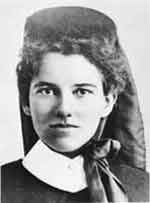 Great Women in Medicine, Sister Elizabeth Kenny
Great Women in Medicine, Sister Elizabeth Kenny
by Jeffrey Dach MD
During the polio epidemic of the 1940’s, mainstream treatment of flaccid paralysis by orthopedic surgeons involved tendon transplant, after which the limb was immobilized and placed in a cast for many months. This was described in the 1913 Journal of Orthopedic surgery here.
Sister Kenny – A Radical Departure from Mainstream Practice
Sister Kenny, an Australian nurse (not a nun) recognized the underlying disorder as muscle spasm and devised a successful treatment of flaccid paralysis with wool strip heat soaks, massage, and muscle exercises, the exact opposite of conventional orthopedic treatment of the time.. Compared to the dismal results obtained by immobilization, Kenney’s active treatment was enormously successful and she was brought to the US in Minnesota where she opened clinics which offered the Sister Kenny treatment for polio victims.
Her life and career was the subject of a Hollywood Movie, starring Rosalind Russell, and a play was also written about her life and career.
Watch this 10 minute You Tube documentary about her life:(2)
Watch this video by the playwright talking about the play of Elizabeth Kenney:
author Jeffrey Dach MD
Links and References
Great Women in Medicine, Sister Elizabeth Kenny
Br Med J. 1943 May 15; 1(4297): 615–616.
Kenny Treatment of Poliomyelitis
Dena Royal Dena Royal Uploaded on May 25, 2010
NHD Documentary 5th place Washington State Junior Individual Documentary (middle schooler.) Represents over 250 hours of work. Please feel free to link, but give credit to student M. Maronde, Oak Harbor HomeConnection.
Sister Kenny’s Children – From the Playwright and the Director
HistoryTheatreMN HistoryTheatreMN
Uploaded on Jan 26, 2010Playwright Doris Baizley and director Ron Peluso talk about the new play “Sister Kenny’s Children” about Sister Elizabeth Kenny (played by Claudia Wilkens) who revolutionized the treatment of polio and laid the foundation for modern physical therapy. “Sister Kenny’s Children” plays January 23-February 14, 2010 at History Theatre, or
Per Hollywood, on her first call, playing Outback nurse Elizabeth Kenny, ca. 1911, Rosalind Russell has received a diagnosis of infantile paralysis for Dorrie (Doreen McCann) and, with aid from her parents (Fay Helm, Charles Kemper), invents her own radical treatment, in Sister Kenny, 1946.Movie clip on sister kenny inventing heaeat treatment to relieve muscl spams of child with polio.
Sister Kenny: Confronting the Conventional in Polio Treatment
By Miki Fairley Content provided by The O&P EDGE
Sister Kenney – The Movie, with clips
Image J Nurs Sch. 1997 Spring;29(1):83-7.
Sister Elizabeth Kenny, an Australian nurse, and treatment of poliomyelitis victims.
SIGNIFICANCE:When faced with the need to “Do the best you can with the symptoms presenting themselves,” Kenny used keen observation to develop a new treatment for poliomyelitis in the early 1900s. Her innovation was to use hot packs to relieve muscle spasms in people with early symptoms of poliomyelitis when orthodox medical treatment included use of splints or casts to immobilize affected limbs.
METHOD: Historical case analysis.FINDINGS AND CONCLUSIONS:
Sister Kenny made bold assertions, obtained scientific validation, learned from experience, used publicity, and opposed resistance. Although some strategies were unsuccessful (and Kenny faced many obstacles) medical practice changed in a relatively short time. Immobilization of limbs was largely discontinued in the acute stage of the disease. Kenny persisted in caring for children who otherwise might have sustained deformities.
Nurs Hist Rev. 2010;18:189-203.
Nurse Irene Shea studies the “Kenny method” of treatment of infantile paralysis, 1942-1943. Golden J, Rogers N.In the 1940s nurses in the United States set out to learn the Kenny method of treating polio patients, which relied on hot packs and muscle strengthening exercises instead of the standard system of prolonged immobilization. Named for Sister Elizabeth Kenny, an Australian nurse who based herself in Minnesota during the 1940s and early 1950s, and viewed with suspicion by many physicians, nurses, and physical therapists, the treatment nonetheless proved effective. It changed the practice of polio nursing and the experiences of patients in the years before vaccine prevention largely eliminated paralytic polio.
Gentle hands – Elizabeth Kenny’s early career
By Dan Olson Minnesota Public Radio August 22, 200210)
Published on Feb 15, 2013
Medical Doctor Susan Humphries speaks on Polio at the Association of Natural Health Conference.
http://drsuzanne.net
http://vaccinationcouncil.org
http://disolvingillusions.com
http://vactruth.com
==============================
by Suzanne Humphries MD (Author) , Roman Bystrianyk (Au










Leave a Comment
You must be logged in to post a comment.